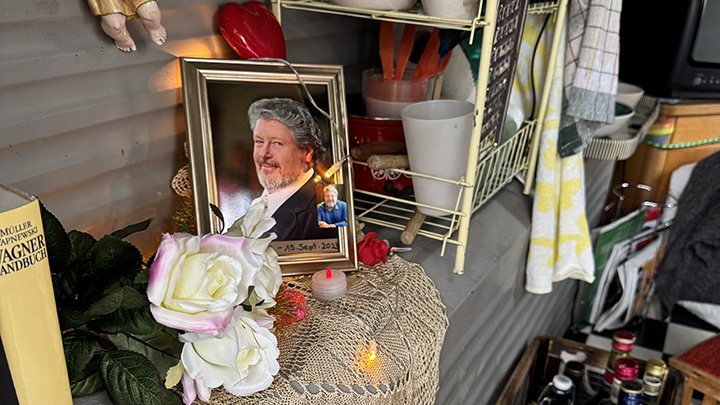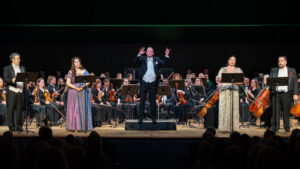Eschewing the sexual discourse that permeates many of the opera’s dramaturgic readings, Kratzer instead channels Wagner’s revolutionary past by masterfully framing the libretto’s opposing realms as a juxtaposition between the anarchic art embodied by Venus’s troupe of libertines and the structured bourgeois formalism codified at the Festspielhaus. Strikingly insightful in its originality and deeply moving in its dramatic execution, Kratzer’s Tannhäuser has since become celebrated as Regietheater operating at its finest, referencing motifs and threading interpretive ideas from Wagner’s life logically and humorously into the score.
As the Overture begins, Kratzter and his video artist Manuel Braun project a film onto the stage that soars over majestic vistas of the Wartburg castle and the lush forests of Thuringia. The camera then focuses down into a scrappy hipster camper van populated by a Zerbinetta/Harlekin-like band of colorful bohemians–the ringleader Venus dressed in a slinky leotard, Tannhäuser made up as a clown, the charismatic, effervescent drag queen Le Gateau Chocolat, and the diminutive, drum-playing Oskar.
Rather than epitomizing the carnal pleasures of the mythical Venusberg, this merry group of anarchists traverses the countryside sowing chaos and propagating their libertine philosophy through posters bearing the motto “Frei im Wollen, Frei im Thun, Frei im Geniessen”–lifted from a pamphlet authored by the young Wagner when he participated in the Dresden May Uprising of 1849. During a poignant moment in the opening montage, the audience broke into spontaneous applause when Oskar is briefly depicted raising a glass to the memory of the late Stephen Gould–one of the aesthetic refreshes that continue to make this production so vital and engaging five years into its run.
Tragedy strikes when Venus runs over a policeman who catches the group scamming a Burger King for a free meal. Upon this juncture, we experience the first of Kratzer’s inspired directorial choices, using the severity of a life lost instead of the titular character’s ennui as a logical motivation for his own jolting back into reality and his departure from the gang.After leaping out of the Citroën, Tannhäuser encounters a cyclist (the shepherd), who guides him back to the Festspielhaus, conceptualized by set designer Rainer Sellmeier as this metanarrative’s proxy for Wartburg.
With vocal score in tow, Heinrich finds himself amid the Bayreuth audience making their “pilgrimage” to the Festival for a performance of Tannhäuser–the very same performance where he is set to appear! As he reconnects with the Minnesingers, his tense, silent confrontation with Elisabeth–an interventionist move that portrays her as an unstable and complex character–sets the stage for the metatheater that Kratzer’s team conceived for Act II. Although Elisabeth’s depiction diverges from her conventional Marian archetype, Kratzer’s decision to evolve the character from this kernel demonstrates yet another one of his concept’s ingenious motivational twists–one that receives a satisfying payoff in the opera’s conclusion.
However, Venus and her gang have other ideas, and pursue Tannhäuser to the Festspielhaus to rescue him. As the first act closes, we see the troupe parked in front of the theater–a segue to a thrilling free-for-all outdoor concert spearheaded by the spellbinding Le Gateau Chocolat. When the curtain falls, the audience descends the hill to a pond, where Le Gateau Chocolat and the team deliver an eclectic drag concert/party featuring covers like Ol’ Man River, Wannabe (Spice Girls), Vogue (Madonna), and a hearty bass rendition of Dich Teure Halle–an indispensable production element that embodies the artistic dichotomies outlined by Kratzer in his dramaturgy.

Act II unfolds as a seamless transition between the realm of film and the metatheater enacted by the artists onstage. The lower half of the set conveys a photorealistic recreation of Wartburg’s historical singer’s hall, whereas the upper half reflects video projections of the backstage area and the exterior of the Festspielhaus. After Elisabeth and Tannhäuser’s reunification, the video transitions to the Venusberg gang invading the theater (In a humorous nod to Lyniv and Stutzmann’s addition to the roster, Oskar and LGC change the name of the conductor’s hall from “Diregenten” to the more inclusive “Dirigintinnen”!) and unfurling a poster on the facade emblazoned with Wagner’s libertine slogan.
Venus mugs one of the actresses due to appear as a page and infiltrates the Wartburg set, acting brazenly out of step with the ensemble. The contest’s stage action initially proceeds in traditional fashion but eventually descends into chaos when the trio ultimately joins Tannhäuser in unapologetically flagrant merrymaking after his impassioned challenge to Wolfram. It is upon Elisabeth’s interjection of “Haltet ein!” that Kratzer arrives at the emotional crux of his vision, tying together his thoughtfully crafted Personenregie into his delineation of opera’s thematic dualities.
Under Kratzer’s direction, Elisabeth no longer represents the idealized virginal saint, but rather a tragic, self-destructive, flesh-and-blood human who realizes that she may never have Tannhäuser, at least not in the reality of “Wartburg” and its formalistic strictures. Just as the scintillating allure of Venusberg’s hedonism tempts Tannhäuser back into its fold, so too does it awaken Elisabeth to the realization that she may not belong within her stifling and moralistic world. Elisabeth’s searing rebuke of Wartburg’s hypocrisy and Tannhäuser’s arrest mark a pivotal turning point for setting up Kratzer’s moving denouement. Venusberg has transformed into a Beckettian wasteland, Le Gateau Chocolat has sold out and advertises luxury watches, and Oskar is homeless, the sole member of the troupe living out his days in the dilapidated hipster bus.
When Elisabeth, in a moment of despair, fails to find Heinrich among the returning pilgrims, she seduces Wolfram and invites him for sex, but only when he is dressed up as Tannhäuser in clown costume–an illusory consummation to ease her towards her tragic end. After they make love in the back of the van, she finally takes her own life. Tannhäuser returns as a disheveled vagrant, and in frustration, he tears up his vocal score and litters the stage with its pages, symbolizing his emancipation from Tannhäuser. When Wolfram reveals Oskar cradling the bloodied corpse of Elisabeth, Tannhäuser comes to her side and the opera arrives at the finale’s staff-sprouting miracle–a final video montage of Tannhäuser and Elisabeth riding the Citroën van into the sunset.
The insights that permeate Kratzer’s vision are truly thought provoking in a manner that transforms perceptions of how both the dramatist and audience can engage a work across its multiple layers. While there is much to marvel about Kratzer’s clever metanarrative reflection of Wagner’s own struggles with evolving politics and art, it is the emotional depth imparted to the main characters that ultimately elevates this Tannhäuser into an extraordinary staging. Although the traditional discourse between pure and erotic love is minimized in this production, Kratzer’s situation of Tannhäuser and Elisabeth within his concept’s dualities arguably fleshes them out as more compelling and tragic beings–both unable to attain genuine human love within the imperfections of Wartburg and Venusberg. And thus, it is with the emancipation afforded by death that the characters extricate themselves from either philosophical extreme to have their happy ending.
Fortunately, Kratzer’s excellent production was supported by an excellent group of soloists that embodied the director’s vision with musicality and intelligence. Klaus Florian Vogt, who performed Act III of the opera in Boston last year, sings a Tannhäuser of integrity and distinction, managing the high lying passages that require flexibility with fluency and ease, while imparting the final act’s Rome Narrative with bite and vivid word painting. Dramatically, Vogt embodied the character’s three facets with the verbal nuance of a seasoned Wagnerian artist–the libertine clown of the first act, the confident Minnesinger of Act II, and finally the world-weary vagrant of Act III. His lover Elisabeth was portrayed by the Norwegian soprano Elisabeth Teige, an ample-voiced singer who can vault into the character’s explosive moments with power. While Ms. Teige’s richly tinted soprano possesses the necessary timbral density to fill the Wagnerian lines, the clarity of her diction could waver and her flickering instrument at times lacked the repose and the gradation of dynamics required to imbue the character’s “Allmächt’ge Jungfrau” with a radiant glow.
Markus Eiche, the veteran Wolfram of this production, sang his character’s solos nobly and ardently, albeit with a baritone that has brightened since its 2019 premiere. If the quality of his singing doesn’t efface the refulgence of recent great Wolframs like Peter Mattei and Gerald Finley, Eiche brings forth verbal subtlety, a complexity and a wounded pride in Kratzer’s fascinating read of the character. Making her Bayreuth debut in the role of Venus, the young Californian mezzo soprano Irene Roberts revealed a lyric instrument of promise in this repertory, compact at the onset but blossoming into a more richly colored, house-filling mezzo with the opera’s progression. As the ringleader of the band of anarchists, Ms. Roberts cut an athletic and charismatic figure onstage, intense and humorously defiant in her character’s embodiment. Günther Groissböck sounded vocally more resonant and freer as the Landgraf Hermann, his registers exhibiting greater evenness and his jaw acrobatics more disciplined compared to his Marke in this Festival’s Tristan.
Among the main characters, Vogt, Eiche, and Groissböck ought to be commended for sculpting Wagner’s lines with impeccable diction. In their brief parts as the Minnesingers, Siyabonga Maqungo floated sweet tones as Walther von der Vogeweide, whereas Olarfur Sigurdarson played a strained and forgettable Biterolf. And while this infectious duo only played silent parts, Le Gateau Chocolat and Manni Laudenbach have consistently been an absolute delight since the production’s inception, enlivening Krazter’s clever mise en scène with their on- and offstage shenanigans. Eberhard Friedrich, the Bayreuth Festival’s chorus director, drew performances of dramatic conviction and verbal clarity from the impressive chorus assembled for this production.
Nathalie Stutzmann debuted at the Bayreuth Festival last year as the third official conductor for Kratzer’s Tannhäuser. Drawing upon her career’s early phase as a contralto, Ms. Stutzmann led a balanced, singer-friendly account of the score that can brim with a vibrancy of colors and a kinetic momentum, both qualities of which were evident in the first and second acts. Strangely, her third act came off a tad stultified, lacking in the rhythmic tautness, the through line, or the tension required to convey the act’s prevailing desolation. The Rome narration, an intense and exposed solo requiring exacting musical repartee between the lead tenor and the orchestra, occasionally flagged and encountered syncing issues. Overall, though, setting the third act aside, Stutzmann led a convincing and theatrical reading that complemented Kratzer’s masterpiece of a production.
Photos: Enrico Nawrath and Christian Ocier







Comments